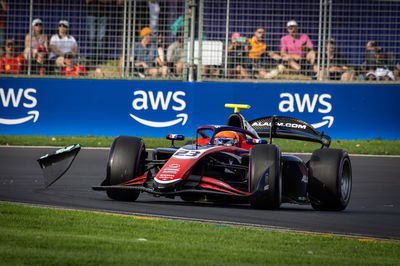New Lola passes crash test.
Lola Cars International has confirmed that its new B2/50 F3000 chassis passed the stringent FIA F1 crash test regulations with flying colours, giving it clearance for introduction next season.
Lola, which has supplied the FIA International F3000 series with chassis since 1996, utilised the experience gained over the last six years in the formula to design a new car that reflects the qualities of contemporary Formula One cars in both look and performance, but still had to prove that it was safe enough for next year's grand prix-supporting championship.
Lola Cars International has confirmed that its new B2/50 F3000 chassis passed the stringent FIA F1 crash test regulations with flying colours, giving it clearance for introduction next season.
Lola, which has supplied the FIA International F3000 series with chassis since 1996, utilised the experience gained over the last six years in the formula to design a new car that reflects the qualities of contemporary Formula One cars in both look and performance, but still had to prove that it was safe enough for next year's grand prix-supporting championship.
The new one-piece monocoque underwent a variety of safety tests at Cranfield's Impact Centre on 15 November, and passed the side intrusion test with a load result of 192.38kN and an energy requirement of 6.6kJ. This test is to the current F1 FIA procedure 02/00 specification; the rules state that during the first 100mm of displacement the load must exceed 150kN and that the energy absorption needs to exceed 6kJ, furthermore there must not be any damage to the fixture or border before these requirements have been met.
The impact tests on the full monocoque to engine bulkhead was conducted with a dummy of 75kg and a fuel cell full of water. The regulations state that the frontal absorbing structure must not exceed 5G on the first 150mm of deformation and must not exceed 25G average deceleration. The average for the Lola was 15.46G. In addition, the dummy's chest should not exceed 60G for a cumulative 3m/s, the peak results in deceleration was only 36.84G.
The extensive FIA safety tests included eight static tests, these were on the monocoque and composite roll hoop structures. The test requires the principal roll structure to meet or exceed 78.8kN load in both a rearward and forward direction. The second roll structure test has a load of 75kN applied through a rigid flat plate 100mm in diameter and perpendicular to the loading access, the new Lola B2/50 F3000 chassis passed both of these tests.
The frontal absorbing structure had a transversal horizontal load of 40kN to which there must be no failure to the structure or of any attachment between the structure and the survival cell.
"Some of the tests were completely new to us and, although nervous, we found it an exciting challenge," revealed Craig Turner, Lola's senior composite engineer, "It was great to get the car to pass the tests, whilst maintaining the tight budget.
"We were delighted with the success of the key elements of the car's design utilising composite materials, in particular the one-piece components such as the wings, flaps and of course the chassis. To reduce weight and pass the F1 tests, a composite rear roll structure was adopted. All in all, it has been a huge success."
The new car offers drivers improved comfort and increased passive safety measures. Its carbon-aluminium honeycomb composite monocoque was constructed using a new specification of carbon fibre, offering greater strength whilst maintaining the same stiffness characteristics and greater impact resistance.
In addition to the improved safety features, the new F3000 cars aerodynamics, uprights and gearbox amongst other components have also been significantly improved, making it more advanced than its predecessor the Lola B99/50.
"We are delighted that the new F3000 car has passed its first crash tests with flying colours." concluded director David Bowes.










